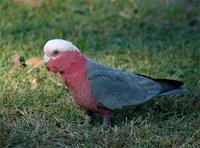Love them, for what they can do.
Hate them for what they will not do, when you want them to.
"No Speaks":
Kookaburras demonstrating my computer's behaviour

Ha, Ha, Ha on me!
A BLOG ABOUT THE NATURE OF ROBERTSON, NSW, AUSTRALIA
ABOUT THINGS WHICH GROW HERE, NATURALLY; SOME OF MY SPECIAL INTERESTS - NATIVE PLANTS AND INSECTS, AND CULTIVARS OF PEONIES AND ROSES WHICH I GROW.
AND ABOUT LIFE IN ROBERTSON, TOO.

 The White C.o.c.k.i.e.s. (Cacatua galerita) were feeding in a deciduous conifer (possibly a Swamp Cypress - Taxodium). Anyway, they love to feed on these trees and similar small-sized Conifer cones, such as the Pencil Pine (Roman Cypress). They easily tear these hard cones apart, then with perfectly precise control of their beak tips and the tongue, they delicately prise out the individual seeds and eat them.
The White C.o.c.k.i.e.s. (Cacatua galerita) were feeding in a deciduous conifer (possibly a Swamp Cypress - Taxodium). Anyway, they love to feed on these trees and similar small-sized Conifer cones, such as the Pencil Pine (Roman Cypress). They easily tear these hard cones apart, then with perfectly precise control of their beak tips and the tongue, they delicately prise out the individual seeds and eat them. Parrots are unique in the world of birds by having flexible upper mandibles. Their top beaks are jointed. This means that not only can they wave their lower beaks around (as we can do with our lower jaws), but they can manouevre their top beak around, back and  forwards, and sideways (limited movement).
forwards, and sideways (limited movement).
Amazingly, this piece of information is omitted from an otherwise interesting article on the different functions of the beaks of birds from the Queensland Museum web site. It does include good photos of the skulls and beaks of a range of bird groups - including a Galah's beak, which it describes as having the multi functionality of a Swiss Army Knife. Interesting analogy. Shame they missed the critical detail of the flexible upper mandible - unique to Parrots.
This level of control is unparalled in the avian world. So it means that not only can they exercise huge power with their large beaks, such as tearing a cone off a tree, but they can bite into it, rip it open, then delicately prise out the seed. Wonderful control.
 White C.....s also feed on the ground, which is the preferred feeding place for Galahs (Cacatua roseicapilla). They are a related bird, but smaller than their White cousins. They tend to eat grass seeds, and also plant roots. That is, except when the small acorned Oaks, known as Pin Oaks come into season. These Oaks have an acorn about the size of a Hazel Nut. When they are ripe, the Galahs of Canberra have a field day (or month). They eat them in the trees, as they ripen; then they eat them from the ground below the trees, when the little acorns fall. Pin Oaks are an introduced tree, native to the USA. From memory their name is Quercus palustris. At least than name has not been blocked.
White C.....s also feed on the ground, which is the preferred feeding place for Galahs (Cacatua roseicapilla). They are a related bird, but smaller than their White cousins. They tend to eat grass seeds, and also plant roots. That is, except when the small acorned Oaks, known as Pin Oaks come into season. These Oaks have an acorn about the size of a Hazel Nut. When they are ripe, the Galahs of Canberra have a field day (or month). They eat them in the trees, as they ripen; then they eat them from the ground below the trees, when the little acorns fall. Pin Oaks are an introduced tree, native to the USA. From memory their name is Quercus palustris. At least than name has not been blocked.
I have finally managed to link to Anni's post of several months ago, where she showed some photos of the wonderful Yellow-tailed Black C.o.c.k.a.t.o.o.s (Calyptorhynchus funereus) feeding on some Banksias opposite her yard. Unfortunately, I could not find that post via a search, as - you guessed it - Net Nanny was protecting me from myself, again. Fortunately, a scroll through her posts produced the result. Anni, cannily headed the post: "On Big Black Birds" - which they are. (Look for March 15's post.) That way, happily you will be free of Net Nanny's inquisitorial eye.
Anni's post has some photo of these huge members of the Parrot clan. In Robertson, their most popular food although not strictly a "natural diet" is the cone of the introduced Pinus radiata tree - the Monterey Pine. These medium-sized Pine Cones (as pine cones go, many are larger) are comfortably torn off Pine trees, chewed open, then delicately stripped of individual seeds. You have to have a huge beak, and wonderful control to do that. I happen to know how hard these cones are to open, as I have attempted the same feat myself, using a pair of pointy-nosed pliers, in order to collect seeds, for propagation purposes. It is not easy.